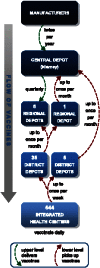Augmenting transport versus increasing cold storage to improve vaccine supply chains
- PMID: 23717590
- PMCID: PMC3661440
- DOI: 10.1371/journal.pone.0064303
Augmenting transport versus increasing cold storage to improve vaccine supply chains
Erratum in
- PLoS One. 2013;8(12). doi:10.1371/annotation/b428dad2-e829-4289-acae-c44369d55a80
Abstract
Background: When addressing the urgent task of improving vaccine supply chains, especially to accommodate the introduction of new vaccines, there is often a heavy emphasis on stationary storage. Currently, donations to vaccine supply chains occur largely in the form of storage equipment.
Methods: This study utilized a HERMES-generated detailed, dynamic, discrete event simulation model of the Niger vaccine supply chain to compare the impacts on vaccine availability of adding stationary cold storage versus transport capacity at different levels and to determine whether adding stationary storage capacity alone would be enough to relieve potential bottlenecks when pneumococcal and rotavirus vaccines are introduced by 2015.
Results: Relieving regional level storage bottlenecks increased vaccine availability (by 4%) more than relieving storage bottlenecks at the district (1% increase), central (no change), and clinic (no change) levels alone. Increasing transport frequency (or capacity) yielded far greater gains (e.g., 15% increase in vaccine availability when doubling transport frequency to the district level and 18% when tripling). In fact, relieving all stationary storage constraints could only increase vaccine availability by 11%, whereas doubling the transport frequency throughout the system led to a 26% increase and tripling the frequency led to a 30% increase. Increasing transport frequency also reduced the amount of stationary storage space needed in the supply chain. The supply chain required an additional 61,269L of storage to relieve constraints with the current transport frequency, 55,255L with transport frequency doubled, and 51,791L with transport frequency tripled.
Conclusions: When evaluating vaccine supply chains, it is important to understand the interplay between stationary storage and transport. The HERMES-generated dynamic simulation model showed how augmenting transport can result in greater gains than only augmenting stationary storage and can reduce stationary storage needs.
Conflict of interest statement
Figures
References
-
- Kaufmann JR, Miller R, Cheyne J (2011) Vaccine supply chains need to be better funded and strengthened, or lives will be at risk. Health Aff (Millwood) 30: 1113–1121. - PubMed
-
- WHO (2010) EVM Assistant Tool.
-
- PATH (2012) CCEM 2.
-
- Isselmou BO (2011) UNICEF and government of Japan boost ‘cold chain’ for immunization in Mauritania. UNICEF. Nouakchott, Mauritania.
-
- Rinzin YC (2012) 16 kerosene coolers for ‘power’less BHUs. Kuensel Online. Phuentsholing, Bhutan: Kuensel Corporation.
Publication types
MeSH terms
Substances
Grants and funding
LinkOut - more resources
Full Text Sources
Other Literature Sources
Medical




